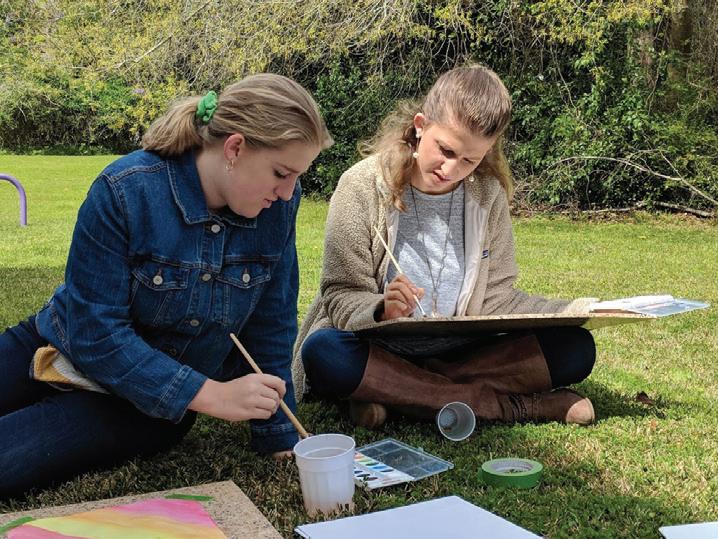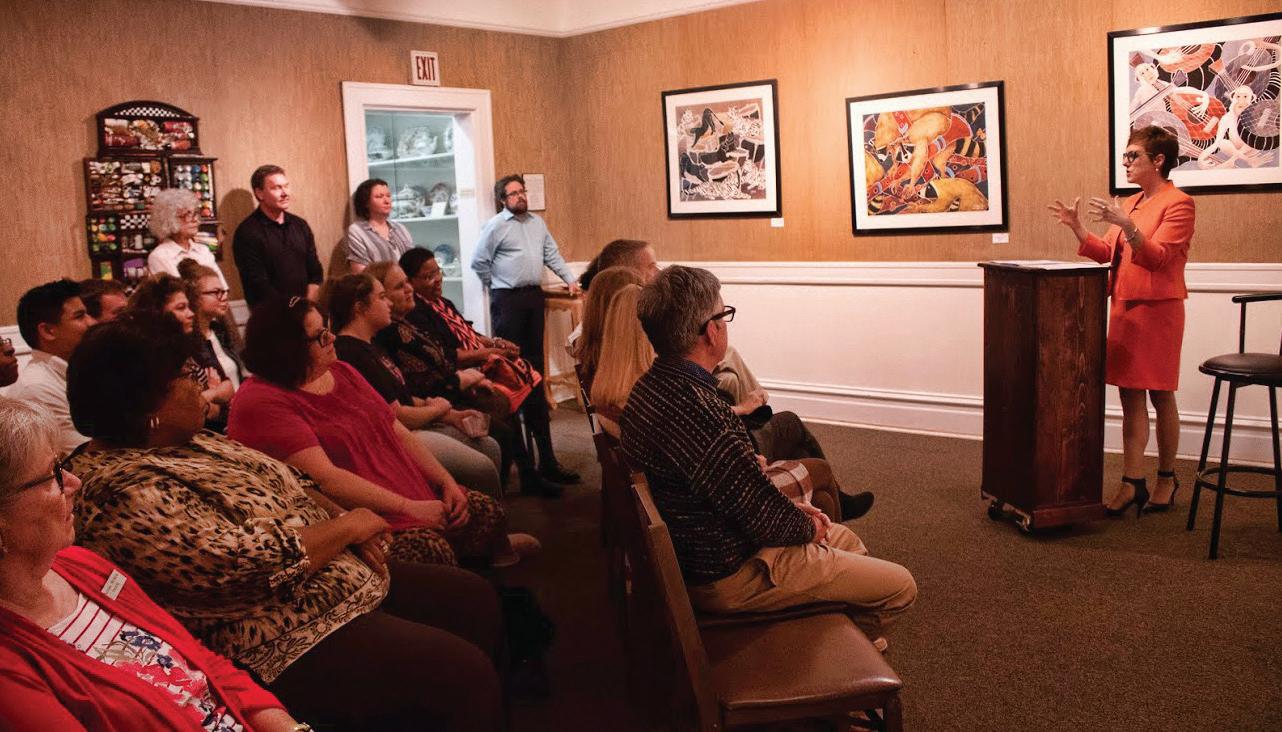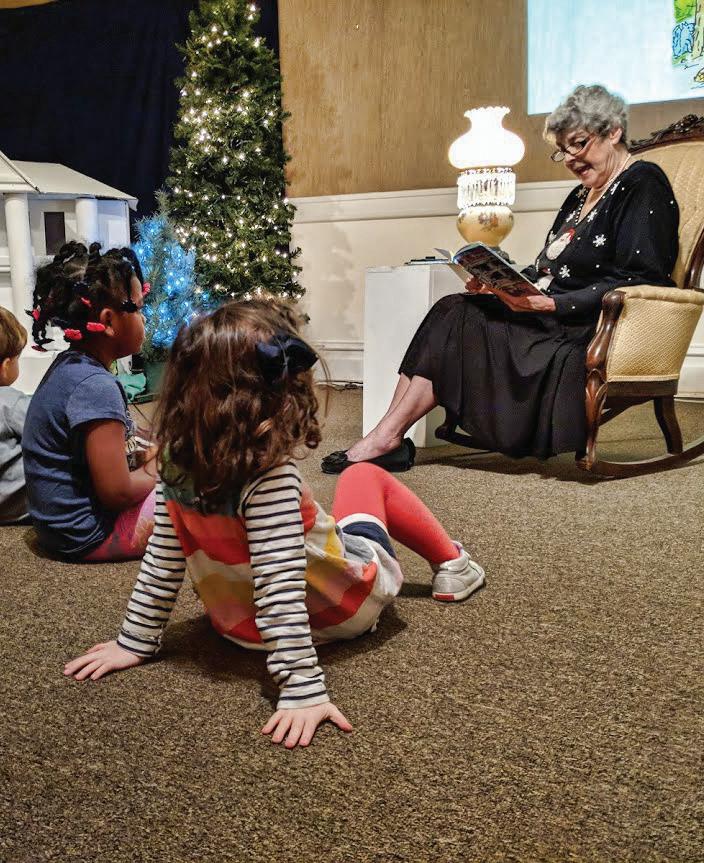
13 minute read
A Return to Glory
With support from the Georgia Council for the Arts and our community, the Altama Museum of Art and History will continue to safely serve our area.
Preserving the Past
Are museums and art galleries still relevant in today’s digital age? Can an image of the Sistine Chapel on a computer screen ever compare to standing beneath Michelangelo’s storied fresco of Biblical scenes and religious events of the times? Of course not. One is a reflection; the other, an experience. Although a visit to a world-class museum is always nice, smaller communities across America have recognized the importance of providing places for history, art, and artifacts in their own communities. In 1980, a group of Vidalia citizens did just that, forming the Altama Gallery, now known as the Altama Museum of Art and History, with the goal of bringing quality art closer to home.
At that time, the Brazell House on Jackson Street with its gigantic columns, multi-hipped rooflines, and grand porches had sat vacant for nearly a decade. In need of a place for their newly-formed nonprofit organization to hold art and historical exhibits, concert performances, and other cultural experiences, the group of art lovers in Vidalia contacted the descendants of the Brazell family about purchasing it. Built in 1911, architect/builder Ivey P. Crutchfield had designed the Brazell House for William Crawford Brazell and William’s wife, Mary Clifton Brazell. Known for his neoclassical style, Crutchfield designed many homes and businesses in Toombs County and across Georgia and Florida. Of those still standing, many are listed on the National Register of Historic Places, including the Brazell House which was added in 1981.
The only occupants to ever live in the house were the Brazell family. The oldest daughter, Emma, and the youngest of the Brazell’s five daughters, Sara, both married. But the middle three daughters did not. Anna, Nora, and Rusha lived out their days in the family home on Jackson Street. People often saw one of the three sisters sweeping the sidewalks or sitting on the porches around the beautiful family home, even in their later years.
Many of the older homes in the historic district, also known as Jackson Heights, had been torn down over the years to make way for “modernization.” The Brazell House was an essential piece of architectural history for our region and a testament to the resilience of those early families in Toombs County. Preservation of the historical landmark would protect an important piece of history as well as provide the perfect space for the newly-formed organization.
When the group contacted the Brazell descendants, the house was in need of a great deal of repair. Not wanting to see their family home torn down, the family graciously agreed to sell the house to the Altama Museum of Art and History for artistic and historical purposes. After extensive renovations, the gallery opened to the public in February 1981.

Youngest daughter Sara Brazell and her new husband Eliza Meadows on their honeymoon.
Maintaining the Present
In 2016, Jennifer Martinez, Jen as most call her, took over as Director of the Altama Museum. She was perfect for the position with her degree in Art from Berry College and a background in professional theatre. Her past work included costume production for the Atlanta Opera, Georgia Shakespeare Festival, and Music Circus in California, among others. She also held the position of Costume Shop Manager for Kennesaw State University’s Theater and Performing Arts program. Jen has brought the organization into the next century through branding, online and social media presence, and by focusing on high quality, family-friendly Arts programming and seeking new ways to engage with the public. Over the years, the gallery’s collections have grown considerably, and now include Southern Contemporary art, antique prints, and decorative arts, including fine furnishings and historic costume. Pointing to one of the beautiful Audubon prints, Jen said, “These were a limited production of very high

The Brazells were the only family to occupy the house. William and Mary Brazell had five daughters. The middle three daughters, Anna, Nora and Rusha, never married and lived out their days in the house.

The gallery’s collections have grown over the years, but its ultimate mission is to engage the community by providing opportunities to educate, promote the arts, and preserve local history. To make this happen, the museum is open from September through May, offering a unique calendar of fine art and historical exhibits, gallery openings, concerts and performances, classes, artist markets and special events.





quality presented in book form and very rare. These prints were the way people learned about species before there were lots of scientific publications and the internet, of course. Anyone who considered themselves a naturalist would have sought copies of these to learn more about the species.” The John Gould (18041881) hand-colored lithographs of birds are another treasure in the gallery’s collection. “John Gould was a famed ornithologist and particularly noted for his beautiful renderings of birds in their natural habitat,” she added.
In large, glass cabinets, the museum displays one of the largest Staffordshire porcelain collections on public view in the United States. Before China closed its borders to Western trade in the mid-1700s, they had been the primary source of most white porcelain. It was discovered that the Staffordshire region of England had the proper clay, an abundance of coal, and salt, all required for ceramic production at that time. Since they could also provide transportation for trade, the region became the new hub of the porcelain market. “There are 211 different patterns and more than 250 individual pieces in our collection,” said Jen. “This is the oldest piece in the collection and was produced between 1775 and 1790,” pointing out a tiny teacup decorated with Oriental design. “The first pieces made in Staffordshire were duplications of the Asian market, and teacups did not have handles. As time went on, handles were added, and the extended pinky while drinking one’s tea became a sign of class and distinction.”

The Second Century Project relied on matching grant donations from the community. When it came time to build, the director and Board of Trustees agreed that sourcing locally would the best way to align with the museum’s vision and honor the community support it has received. From the architect and contractor to the builder and landscapers, the museum was able to coordinate work with local businesses during a pandemic and within a time constraint–which was no small feat, but perfectly timed.

When Jen first took over as Director, she knew the place needed a fresh coat of paint. “But upkeep on a 4000-square-foot century-old house is no small expense. Funding for a 501c3 is ‘always a thing,’” she said with a warm smile. “Most of the funding for day-to-day operations comes from private donations, museum membership revenue, and corporate sponsorships. We also receive some funding from the city of Vidalia.” These funds enable the gallery to serve the community and visitors free of charge. But if the present generation hoped to preserve the collections and continue to bring in artistic opportunities, work would need to be done on the largest item in the museum’s collection, the Brazell House itself.

Local architect Fred Dean of Dean Architecture and Design created the drawings to guide the renovation project.
Preparing for the Future
“There’s a common misconception about grant funding for nonprofits,” said Jen. “While there are many grants available for programming, to bring in artists or host a particular class, for example, there are few available for ‘brick and mortar’ rehabilitation projects or operating funds. So, the ones that do come out are highly competitive.”
By early 2020, the Brazell House needed much more than a fresh coat of paint. Unmindful of the global pandemic and the economic disruptions that ensued, deterioration on the 109-year-old Brazell House could not

Jennifer was able to match the original ‘haint blue’ color for the porch ceilings when samples of it were found under several layers of paint.
wait for a more convenient time. Structural repairs and threats to safety and accessibility had to be addressed. The Altama Museum had already contracted with area architect Fred Dean of Dean Architecture and Design to assess the scope of work and produce drawings to guide a renovation project that, at that point, seemed likely to be done in stages over the course of years due to budget constraints. When Georgia Council for the Arts offered Cultural Facilities Grants with awards up to $75,000, it seemed an answer to the organization’s prayers and meant the possibility of accomplishing all the major goals in a shorter time frame might be a reality.
The deadline to apply for the grant was the end of June of 2020 and terms required that an organization prove they could obtain 50% of the grant money through matching donations. The Altama Museum’s board of Trustees wasted no time launching a fundraising campaign for the purpose, aptly entitled the Second Century Project. Contributions made by Sweet Onion Classic, Altamaha Bank and Trust, Georgia Power, descendants of the Brazell family, and many others, both corporate and private, enabled the organization to meet this requirement.
Finding a general contractor with experience in historical building renovation was relatively simple. Finding one who was also available to work within the constraints of the grant-stipulated project completion date of June 30, 2021 was no small task—and the grant required three competitive bids. “Our greatest competition for GCs was an abundance of new construction projects and the many industries that were taking advantage of lower demand on facilities due to COVID restrictions to make improvements and additions to their commercial spaces.
“We waited four agonizing months to find out if we were going to receive the grant,” said Jen. “And we had to ask our bidders to be on deck until October of 2020 when awards were announced. There was no guarantee on the amount of money we would receive, if any. We were hoping for the best and preparing for the worst. There was a lot of trust involved.”
Because the Altama Museum cannot exist without the support of the community, the director and trustees made a commitment to utilize as many local subcontractors, suppliers, talent and resources as possible. “Because we would be receiving support from Georgia Council for the Arts through the appropriations of the Georgia General Assembly, it was important to us that that money stay in this area,” said Jen. “We secured Kelvin Manning, owner of MMI Construction and Engineering in Uvalda, to provide general contracting services. He’s worked on a lot of projects in our area, including renovations on the Pal Theatre and other historic properties. We knew his work to be exceptional.”
Word finally came in late October that the Altama Museum of Art & History had indeed been awarded the grant. But as one time of waiting ended, another began.
“We had rain for days and days,” said Jen. “Then, when the rain stopped, it was already the holidays. Work was finally able to begin just after the first of the year.”
As soon as the renovation process got underway, crew with GG Landscaping and Design discovered original masonry septic tanks while removing a mess of vines and overgrown shrubs behind the back walkway. The two cisterns were six feet deep by four feet wide and had openings in the top just big enough for a small child to fall into. It was an unexpected hit to the budget right off
the bat. “Now I know why that oddly placed garden was there,” said Jen. “But thankfully, the solution was simple and permanent to have them filled with sand.” Addressing safety and accessibility concerns was a major priority of the Second Century Project.
The foundation needed only a small portion of underpinning and brick skirting repaired, which was quickly completed by Mr. Sam Gaffney, and DBM Roofing replaced a leaky porch roof with new durable material that should stand the test of southern storms. Rhodes Electric oversaw the installation of new exterior lighting for security and aesthetics, among other improvements. Fortunately, the “knob and tube” electrical wiring had been replaced during an earlier renovation in the ‘90s. Knob and tube wiring was fabric-wrapped wiring mounted to little ceramic knobs that went through the walls. Because it was cloth-covered, it was attractive to pests like rodents. As a result, it’s been responsible for a lot of electrical fires in older homes. But the porch, railings, and ramp required a great deal of repair. “Over the years, the porch had deteriorated with water damage,” said Jen, “and the railings were falling apart in places. The ramp had also rotted and become unstable.” With an eye toward ecological responsibility, new wood was only used where deterioration was beyond repair. When Harry and Jackie Moses renovated the house behind the museum, Jen asked for the old tongue-andgroove porch decking, which was being removed and slated for the city dump. “The house behind us was built only about ten years after the Brazell House, so we were really excited to utilize that material to repair our porch. It’s historically accurate, environmentally responsible, and budget-friendly.” When the work was complete, approximately 250 linear feet of the railing had been rebuilt and brought up to code.
One of the stipulations to being on the National Register of Historic Places is that any repairs or replacements must be as close to the original as possible. Since modern wood is milled thicker or thinner than the original heart pine used for siding on the Brazell House, lumber for repairs was custom milled to the correct size by H.V. & T.G. Thompson Lumber Co. in Ailey. With so much wood work to replicate according to National Register standards, attention to detail is important. “The quality of workmanship by our carpenters, Harry Harper, Jr. and Trey Squires, has been outstanding,” said Jen. Harry Harper Construction Company provided both construction and painting services.
Adding a new ADA-compliant restroom was a much-needed update, as the old restroom was claustrophobic with a step down and an undersized door. With the aid of designers Lyndi Dean and Stephanie Dunham, and guidance from Wheeler Plumbing, traditional fixtures were sourced that balanced design details appropriate to the home when it was first built with highly specific requirements of the Adults With Disabilities Act. An antique stainedglass window was sourced from Red Wagon Market in Lyons to bring much-needed light and architectural interest to the space. When asked about the small size of the former bathroom door and its opening, Jen said, “The bathroom door was purposefully smaller so you could tell which room was the bathroom without having to ask your host or accidentally entering a private space in the house.”
The exterior of the house received a full coat of paint, top to bottom, with shutters by gTs Plantation added in strategic places to create a more pleasing look than the backs of interior display walls. In keeping with Southern tradition, the porch ceiling was repainted its original shade of “haint blue,” which could still be found under layers of peeling white paint. “Haint is a Southern variation of the word haunt, which refers to a spirit or a ghost,” explained Jen. “According to folklore, the blue represented water. It was believed that spirits couldn’t cross water, so

people would paint their porch ceilings ‘haint blue’ to keep them away. I’ve also heard it keeps wasps from building nests.” Jen added with a smile, “If the color only keeps out one, make it wasps!”
The restoration work on the Brazell House ensures that the Altama Museum of Art & History in the historic Brazell House will continue to open its doors for many years to come and fulfill its mission to educate, promote the Arts, and preserve the history of the region, in a safe and accessible environment to the enjoyment of all. From September through May, the museum offers a unique calendar of fine art and historical exhibits, gallery openings, concerts and performances, classes, artist markets, and special events.
As the pandemic slowly loses its grip, months of disruption to everyday life continue to take their toll. Countless studies have proven the benefits of art to our physical and mental health. But a reflection from a computer screen will never compete with the experience of standing in front of a painting and allowing the colors and images to awaken your senses.
The Altama Museum of Art and History continues to provide opportunities like these because of the support of the community. As we support the gallery, the gallery supports us. Art, history, and culture can help free us from the mentality of isolation that continues to linger in the aftermath of these past few months. With the restoration work of the Second Century Project complete, we can enjoy the restoration of community life together as we pass through the “haint blue” waters and leave the ghosts of this past year behind.
For more information or to support the Altama Museum, visit their website at AltamaMuseum.org or contact Jen Martinez, Director at (912)537-1911 or altama@bellsouth.net. (Also, on Instagram or Facebook @AltamaMuseum.)







